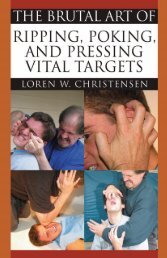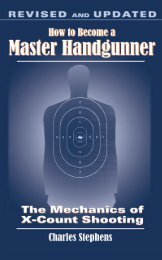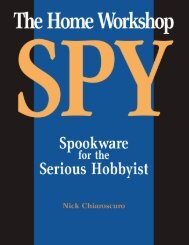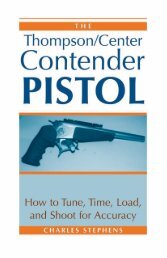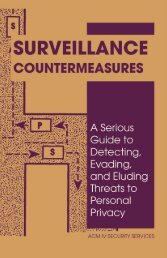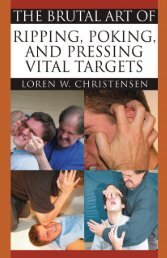to read a free sample chapter from this book. - Paladin Press
to read a free sample chapter from this book. - Paladin Press
to read a free sample chapter from this book. - Paladin Press
You also want an ePaper? Increase the reach of your titles
YUMPU automatically turns print PDFs into web optimized ePapers that Google loves.
4 The Tactical MarksmanA <strong>read</strong>y but safe boltposition for target areacoverage. Do not lockdown unless the situationrequires it.power of a bullet, especially a high-powered riflebullet, needs <strong>to</strong> be kept in mind at all times. Safemuzzle control means not covering any undeservingperson, including yourself. When you caseyour rifle or holster your pis<strong>to</strong>l, control your muzzle.When using your long gun and wearing asidearm, be aware of the muzzle directions of both.A poor sidearm holster selection can position yourpis<strong>to</strong>l so that it is pointed at you; and in some rifleshootingpositions, inattention <strong>to</strong> your holsteredpis<strong>to</strong>l’s position can lead <strong>to</strong> covering others in thearea, such as the range officer behind the prone firingline.The tactical marksman must develop a techniquefor being instantly prepared <strong>to</strong> fire withoutviolating <strong>this</strong> or other safety rules. The bolt-action rifle can be fully loaded and keptat the “safe <strong>read</strong>y” by keeping the bolt handle raised and the firing pin locked inplace. The muzzle should be directed <strong>to</strong> a safe area, and the bolt handle should notbe closed until a shot is justified. The fully loaded semiau<strong>to</strong> rifle can be kept at the<strong>read</strong>y by activating the manual safety and keeping the muzzle off target in a safearea. Do not directly view targets through a mounted rifle scope unless the action isjustified. Thoroughly test your equipment <strong>to</strong> ensure that it will not unintentionallydischarge during a hard, fast-bolt lockdown or deactivation of the manual safety.This is especially important under extreme cold conditions where improper lubricationcan cause weapons <strong>to</strong> <strong>free</strong>ze up.KEEP YOUR FINGER OFF THE TRIGGER UNTIL YOUR SIGHTSARE ON THE TARGET AND YOU ARE PREPARED TO FIREHaving your finger on the trigger before your sights are aligned is an unintentionaldischarge waiting <strong>to</strong> happen, especially with a finely tuned rifle trigger. If youare justified in shooting a target, align your sights on the target before placing yourfinger on the trigger. Until your sights are aligned your shot placement is not confirmed.An unintentional shot could be disastrous. Properly trained shooters developa trigger finger that operates separately <strong>from</strong> the grip pressure of the rest of thehand. A well-trained trigger finger is not prone <strong>to</strong> unintentionally releasing the shot,even when the shooter is startled.BE SURE OF YOUR TARGET AND WHAT IS BEYONDThis is a simple yet effective statement that all <strong>to</strong>o often goes unheeded. Youdo not shoot at noises, shadows, or movements. You must identify your targetand confirm a safe backs<strong>to</strong>p behind your target before firing. For the tacticalmarksman in a hostage situation, for instance, <strong>this</strong> may be an exacting task:hostage takers using disguises and/or live shields can make <strong>this</strong> extremely difficultat times. Nevertheless, the rule must be adhered <strong>to</strong>. On occasion, the tacticalmarksman will have <strong>to</strong> adjust his position <strong>to</strong> ensure a safe backs<strong>to</strong>p—as in





